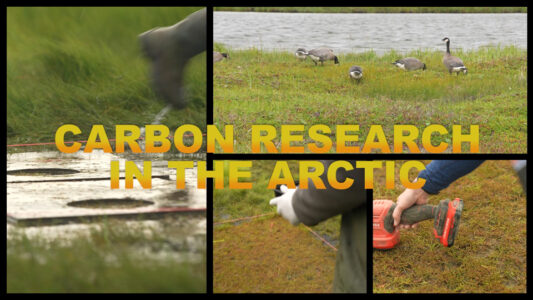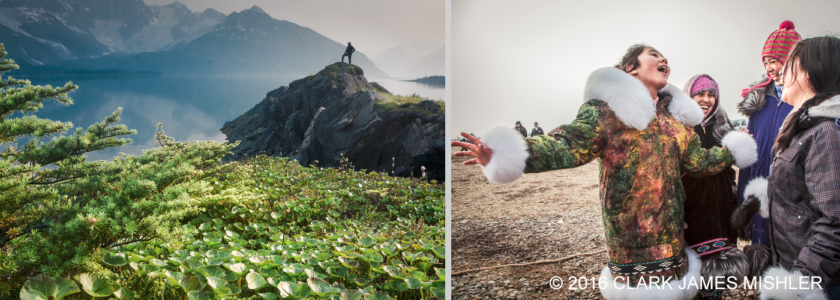
Bone specimens at the University of Alaska Museum of the North once belonged to members of a newly defined dinosaur species: Ugrunaaluk kuukpikensis. So far nearly 6,000 individual bones have been cataloged from a group of mostly juvenile dinosaurs of U. kuukpikensis that died on the Arctic flood plain 69 million years ago in a place today known as the Liscomb Bone Bed on the banks of Alaska’s Colville River. U. kuukpikensis was a species of plant eating duck-billed dinosaur in the family Hadrosauridae.
Lead researchers defining the new species include Pat Druckenmiller, earth sciences curator at the Museum of the North and geology professor at the University of Alaska Fairbanks; Greg Erickson, paleobiologist, biological sciences professor at Florida State University; and Hirotsugu Mori, a University of Alaska Fairbanks graduate student who contributed completed doctoral work on the species. To read their recent paper check out ‘A new Arctic hadrosaurid from the Prince Creek Formation (lower Maastrichtian) of northern Alaska‘ Hirotsugu Mori, Patrick S. Druckenmiller, and Gregory M. Erickson, Acta Palaeontologica Polonica, 22 Sep 2015 doi:http://dx.doi.org/10.4202/app.00152.2015

Naming
I love the newly described dinosaur’s name. Instead of depending on Latin language roots to name the species, the researchers consulted Alaska Fairbanks Alaska Native Language Center instructor Ronald (Aniqsuaq) Brower, Sr and others to develop the species’ name. This was a collaborative effort between scientists and Iñupiaq speakers of the Iñupiat language, spoken by the Native people who live in the Colville River area.
Ugrunaaluk (oo-GREW-na-luck) kuukpikensis (KOOK-pik-en-sis) in brief can be translated to ancient grazer. ‘Ugru’ denotes plant grinding, to describe the way the dinosaur used long rows of grinding teeth to chew plants. ‘Naluk’ has the meaning very old with a respectful connotation; Native Iñupiaq speakers might refer to a very old relative as ‘naluk’. Kuukpikensis references the Native name for the geographical location where the dinosaur bones were found along the Colville river.
Past climate, past place

U. kuukpikensis’ environment wasn’t as harsh as today’s North Slope. Today annual average temperatures measure as low as 12° Fahrenheit. In contrast Erickson said Colville area annual temperatures 69 million years ago probably averaged about 40° Fahrenheit. River systems on the ancient Arctic flood plain helped vegetation thrive during the sunny summer season. While plants probably didn’t grow during cold months, it’s likely that some vegetation hunkered down and survived. During four months of polar winter darkness the area would have endured temperatures below freezing and, probably, snow. These herbivorous dinosaurs are depicted as having roamed in herds and survived by for plant life, using hundreds of grinding teeth to cope with coarse vegetation. At the time their environment supported polar forests – words that Druckenmiller said certainly wouldn’t go together to describe today’s Arctic. In today’s North Slope environment permafrost dominates and limits plant height because roots can’t penetrate frozen ground.
The dinosaur species lived during what’s called the Age of Dinosaurs, the Mesozoic Era (252 to 65 million years ago), and more specifically during the Cretaceous Period (146-65 million years ago). The dating putting this group of U. kuukpikensis at 69 million years old sneaks them in ‘shortly’ (geologically speaking) before dinosaurs went extinct 65 million years ago. During the Cretaceous, the place they lived was actually located even further North; Alaska has been brought South over a long period of time – remember continental drift? Tectonic plates move over time, and through paleomagnetism researchers can use minerals in rocks recovered from the dinosaurs’ Liscomb Bone Bed resting place to find evidence that they lived at 79° North.
Druckenmiller described dinosaurs found in Alaska’s North Slope “These were the northern-most dinosaurs to have lived during the Age of Dinosaurs. They were truly polar.”

Warm-blooded?
The polar environment raises questions. Before the 1960s paleontologists portrayed all dinosaurs as cold-blooded creatures. No longer. Cross-sections of U. kuukpikensis bones can provide some clues. After all, North Slope dinosaurs dealt with cold temperatures. The Bureau of Land Management provides this information in their packet ‘Dinosaurs on Alaska’s North Slope‘:
“The bone cross-sections of warmblooded mammals have more blood channels while the bones of coldblooded reptiles have fewer channels. Some dinosaur bones show a combination of both patterns, with more blood channels as juveniles, and fewer channels in adults. North Slope dinosaurs so far exhibit a juvenile pattern. The debate isn’t settled. It may be these dinosaurs had unique metabolisms unlike animals today.” ~BLM
Epic field work

The field work involved is extreme. The scientists describe the logistics as a 500 mile trip up the Haul Road from Fairbanks, a charter plane trip to the site, then rappelling down cliffs to the bone sites. There are tents and bugs, rubber boats and choppy waters. They excavate patiently then tote heavy fossils encased in plaster. They deal with surprise snow. This dedication is followed by careful inspection of bones in the lab at the Museum of the North.
It’s also rewarding. Findings in Alaska are molding what the world believes about dinosaurs. These ancient species lived in conditions once thought impossible for dinosaurs to survive. There have been more dinosaur species and dinosaur fossils found in Alaska than in the rest of the polar regions combined. Erickson said “The finding of dinosaurs this far north challenges everything we thought about a dinosaur’s physiology.” It sparks a scientific curiosity. “How did they survive up here?”

A discovery story
The first dinosaur bones discovered in Alaska were spotted at the Liscomb Bone Bed in 1961. Robert Liscomb, a geologist working for Shell Oil Company, was mapping along the Colville River. He assumed the bones were from Ice Age mammals. It wasn’t until 1984 that the fossils were closely examined by a U.S. Geological Survey geologist and identified as dinosaur bones.
“It appears that a herd of young animals was killed suddenly, wiping out mostly one similar-aged population to create this deposit,” according to Druckenmiller. The U. kuukpikensis juveniles measured about 3 feet tall at the hip and 9 feet long. Adults could grow to 7 feet tall at the hip and 30 feet [9 meters] long. They sported crests along their backs. With long hind legs and short front legs, the herbivores could stand on back legs alone or could walk on all fours.
At first the bones from juvenile U. kuukpikensis were believed to be a different species of Hadrosaur named Edmontosaurus, common in more southerly parts of North America from Canada to South Dakota. However, formal examination of the fossils betrayed differences denoting a different species. It is the fourth dinosaur species unique to Alaska formally named in scientific literature. The sheer number of bones helps define the species; every bone in the species’ body is represented more than once in the Liscomb Bone Bed collection. Skull and mouth features are especially telling. Mori described: “The new species has a unique combination of characteristics not seen in other dinosaurs.”
Many remains from Alaskan dinosaurs cannot be formally identified as a species because of incomplete skeletons. But of those that have been identified, Druckenmiller explained “The dinosaurs that we had living here in the Arctic were completely different species from those who lived at the same time at lower latitudes.” So-far-defined polar-dwelling dinosaur species are distinct from the dinosaurs living in more southerly latitudes. “That suggests we had our own unique polar community up here.”
Every new fossil find opens up new possibilities for science. I’m excited to keep an eye on U. kuukpikensis and other new – old members of the polar dinosaur community.
Visit the University of Alaska Museum of the North in Fairbanks for the special exhibit Expedition Alaska: Dinosaurs. Touch a Hadrosaur bone. Upcoming, see new additions: 3 skeletons of juvenile U. kuukpikensis. Alaska dinosaur new species Hadrosaur Ugrunaaluk kuukpikensis
More resources about dinosaurs are available from Alaska Public Lands Information Center – Alaskan Dinosaurs
Laura Nielsen 2015
Frontier Scientists: presenting scientific discovery in the Arctic and beyond














